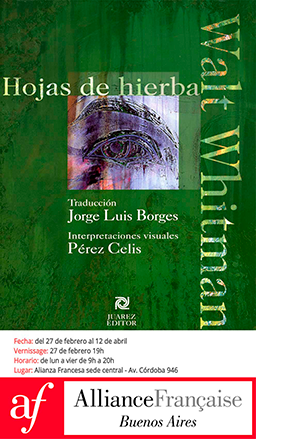DENOUNCEMENT AND ORIGIN IN TABITA REZAIRE
Nebulosa de la calabaza is the title of the first solo exhibition presented in Spain by Tabita Rezaire (Paris, France, 1989), an artist living in French Guiana. Renowned for her use of new media and multidisciplinarity to explore the relationship between contemporary worlds transited from technology and their relationship with the most ancestral and spiritual environment, the Guyanese-heritage artist focuses her production on activism from the perspective of denunciation from feminism and decolonization as key points.
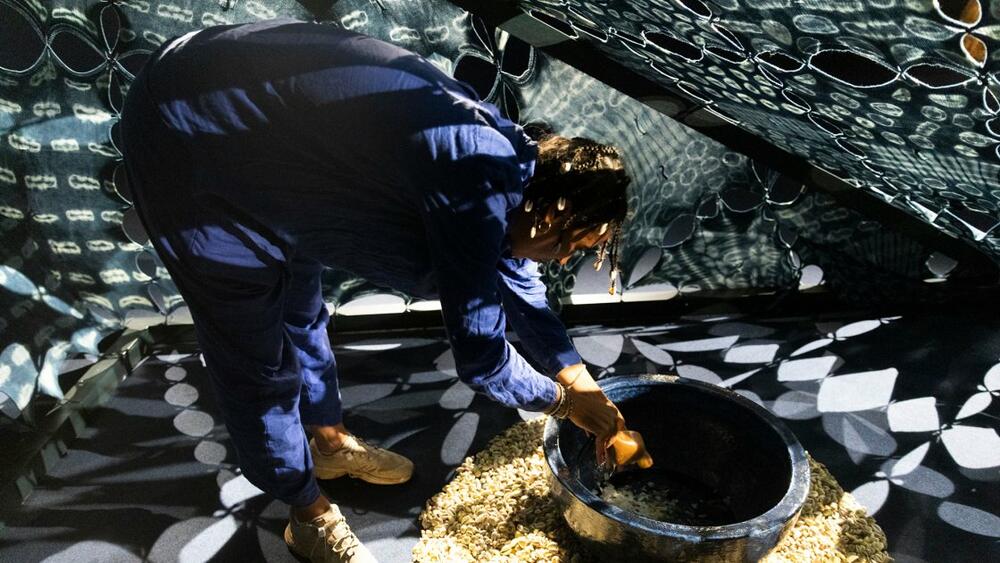
For that reason, it is not surprising that the Museo Nacional Thyssen-Bornemisza and the TBA21 Thyssen-Bornemisza Art Contemporary Foundation, organizers of the exhibition, have opted to present a show that has fit perfectly into the curatorial lines that, for some time now, the Madrid institution has been executing and that deal with the decolonizing urgency and the feminist approach.
However, the exhibition does not delve into the formal aspects of Rezaire's best-known techniques, or not at first glance, and Nebulosa de la calabaza ends up by picking up a proposal much more focused on the roots and the primordial in which those new technologies take a back seat to express, in a masterful way, the reunion with the origin buried under Western influence.
In a more or less participatory way, the artist proposes through three installations the understanding and connection with this vital cycle and spirituality as a means. Just as the maxim that the last thing a people has left is its religion and its language is understood, the former takes on an essential protagonism. Of the three works or spaces presented, two of them are dedicated to the orisha Yemoja, the main spirit of the Yoruba religion, mother of rivers and oceans, symbol of the origin and perpetuity of life, and which channels the viewer's interaction to find an immaterial connection through space.
It is precisely the construction of these immersive environments that serves to enclose the possibilities of interconnection and even the performance by the spectator of rituals without disengaging from certain techniques that, like video or the arrangement of the elements, allude to the counterbalance of reality. This invitation to participation leads to mimicry for a limited time in the original knowledge through the vehicle of the rite, one of those anchor points that can well be used as an instrument for the reconstruction of the primordial belonging and collective identity and that, unfortunately, is not complemented by that of the own language, absent in favor of that of the colonizer, also an element of repression and eradication.
-
Tabita Rezaire. Nebulosa de la calabaza en Thyssen Bornemisza
-
Tabita Rezaire. Nebulosa de la calabaza en Thyssen Bornemisza
-
Tabita Rezaire. Nebulosa de la calabaza en Thyssen Bornemisza
-
Tabita Rezaire. Nebulosa de la calabaza en Thyssen Bornemisza
-
Tabita Rezaire. Nebulosa de la calabaza en Thyssen Bornemisza
-
Tabita Rezaire. Nebulosa de la calabaza en Thyssen Bornemisza
-
Tabita Rezaire. Nebulosa de la calabaza en Thyssen Bornemisza
Tabita Rezaire. Nebulosa de la calabaza can be seen until January 12, 2025 at the Museo Nacional Thyssen-Bornemisza, Paseo del Prado, 8, Madrid (Spain).
May interest you

The Studiotopia international program is open for the submission of proposals to the residency program for young scientists or emerging artists. LABoral Centro de Arte y Creación Industrial -in collaboration with other institutions- announces an international call for non-Spanish artists. Deadline to apply: November 7, 2024.
SCIENCE & ART: STUDIOTOPIA INTERNATIONAL OPEN CALL
The Studiotopia international program is open for the submission of proposals to the residency program for young scientists or emerging artists. LABoral Centro de Arte y Creación Industrial -in collaboration with other institutions- announces an international call for non-Spanish artists. Deadline to apply: November 7, 2024.

The Studiotopia international program is open for the submission of proposals to the residency program for young scientists or emerging artists. LABoral Centro de Arte y Creación Industrial -in collaboration with other institutions- announces an international call for non-Spanish artists. Deadline to apply: November 7, 2024.
SCIENCE & ART: STUDIOTOPIA INTERNATIONAL OPEN CALL
The Studiotopia international program is open for the submission of proposals to the residency program for young scientists or emerging artists. LABoral Centro de Arte y Creación Industrial -in collaboration with other institutions- announces an international call for non-Spanish artists. Deadline to apply: November 7, 2024.
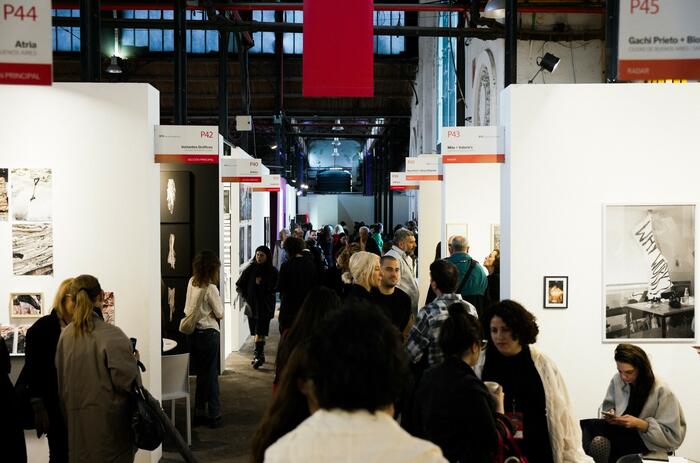
Pinta BAphoto closed its 20th anniversary at La Rural, Buenos Aires, Argentina, after a weekend that brought together the best of photography in the region and was a meeting point for gallery owners, artists, curators, collectors and photography lovers. The fair attracted more than 14,000 visitors during its three days open to the public.
PINTA BAphoto - THE EXPRESSION OF A REGION'S PHOTOGRAPHY
Pinta BAphoto closed its 20th anniversary at La Rural, Buenos Aires, Argentina, after a weekend that brought together the best of photography in the region and was a meeting point for gallery owners, artists, curators, collectors and photography lovers. The fair attracted more than 14,000 visitors during its three days open to the public.
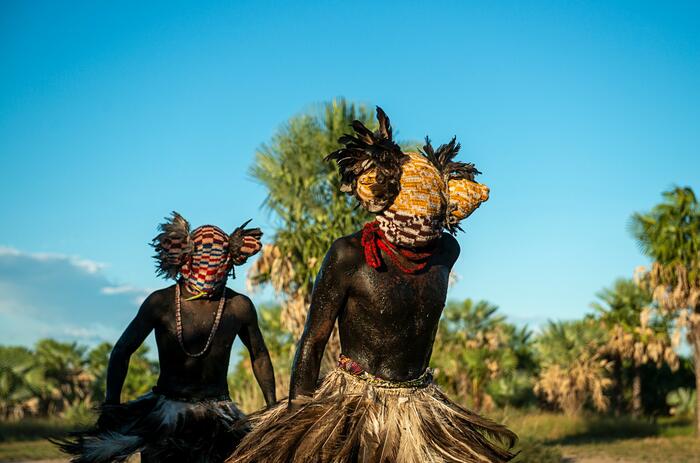
Confines of Paraguay is the initiative of Fernando Allen and Fredi Casco that is part of the Main Section of Pinta BAphoto. It is a project that began with a photographic approach, but expanded into an editorial, audiovisual and documentary archive -along with other activities- related to the works of popular and indigenous artists from Paraguay.
FERNANDO ALLEN AND CONFINES OF PARAGUAY IN PINTA BAphoto 2024
Confines of Paraguay is the initiative of Fernando Allen and Fredi Casco that is part of the Main Section of Pinta BAphoto. It is a project that began with a photographic approach, but expanded into an editorial, audiovisual and documentary archive -along with other activities- related to the works of popular and indigenous artists from Paraguay.
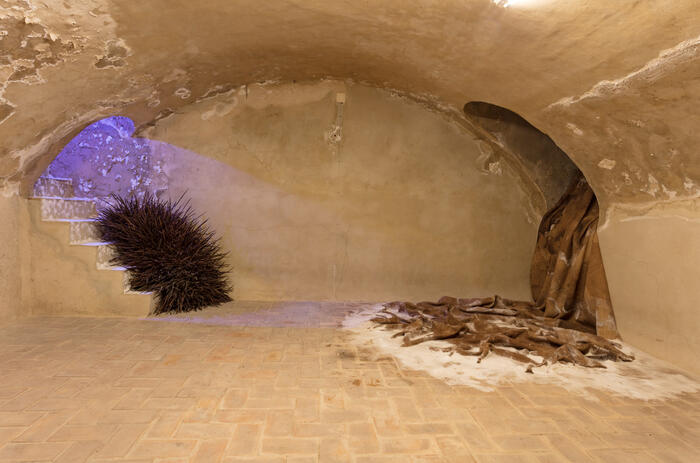
The Andalusian Center for Contemporary Art (CAAC) is showing Continuum or the appearance of the parts and the whole in its recovered space in the cellars of the institution's complex in Seville, an exhibition whose origin is to be sought in Profundis, the proposal that Colombian Delcy Morelos (Tierralta, Colombia, 1967) made for this same center this year and that served as a framework to sublimate, from the analysis, the dialogue beyond the material and the relationship she kept with her collaborators when it came to putting together her recent exhibition.
CONTINUUM: FROM THE DIALOGUE WITH DELCY MORELOS
The Andalusian Center for Contemporary Art (CAAC) is showing Continuum or the appearance of the parts and the whole in its recovered space in the cellars of the institution's complex in Seville, an exhibition whose origin is to be sought in Profundis, the proposal that Colombian Delcy Morelos (Tierralta, Colombia, 1967) made for this same center this year and that served as a framework to sublimate, from the analysis, the dialogue beyond the material and the relationship she kept with her collaborators when it came to putting together her recent exhibition.
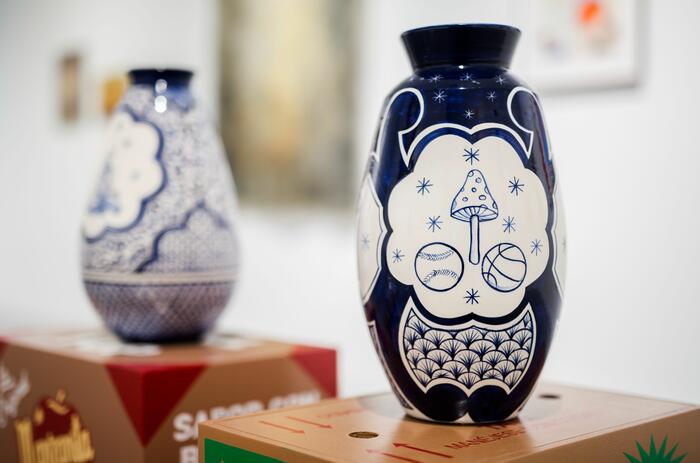
In an art industry that increasingly advocates following the lines established by cultural policies, it is always comforting to return to thesis themes, to environments that draw from social and historiographic sources, of course, but also from myths and a well-understood anthropology. You can go deeper in subtitles and lines or you can put together a skeleton, but the overview can also be a reward these days.
THE FIRE KEEPERS, A PERSPECTIVE ON THE MYTH OF FIRE FROM A MEXICAN CURATORIAL PERSPECTIVE
In an art industry that increasingly advocates following the lines established by cultural policies, it is always comforting to return to thesis themes, to environments that draw from social and historiographic sources, of course, but also from myths and a well-understood anthropology. You can go deeper in subtitles and lines or you can put together a skeleton, but the overview can also be a reward these days.
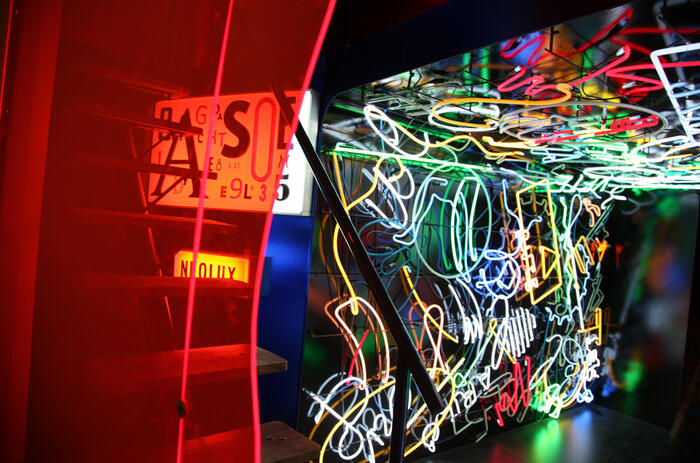
The Museo Moderno announced that La Menesunda, the legendary work by Marta Minujín and Rubén Santantonín –a work originally created in 1965, reconstructed by the Museo de Arte Moderno de Buenos Aires and inaugurated in 2015 and later in 2019 at the New Museum in New York– is on view for the first time in Europe as part of a tour that will show it in four countries.
THE EUROPEAN TOUR OF 'LA MENESUNDA' ACCORDING TO MARTA MINUJÍN
The Museo Moderno announced that La Menesunda, the legendary work by Marta Minujín and Rubén Santantonín –a work originally created in 1965, reconstructed by the Museo de Arte Moderno de Buenos Aires and inaugurated in 2015 and later in 2019 at the New Museum in New York– is on view for the first time in Europe as part of a tour that will show it in four countries.
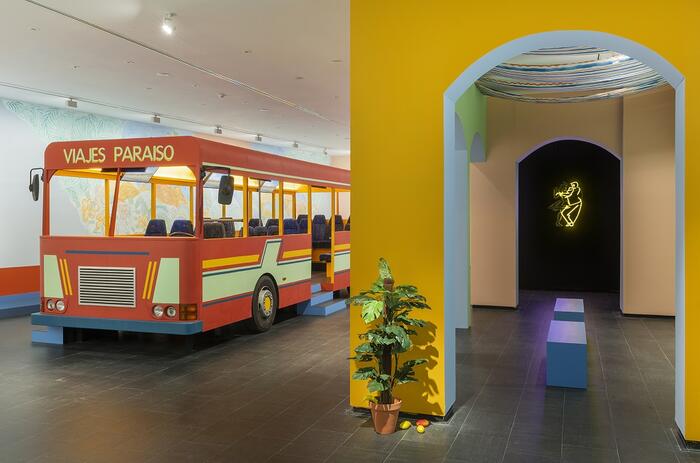
Sol Calero (Caracas, Venezuela, 1982) uses the guanabana, a fruit endemic to Central America and the Caribbean, to symbolically instrumentalize the creation of a representation of the feelings of belonging, home, everyday life and stereotypes through the wide conquest of the spaces of the Museo Centro de Arte Dos de Mayo, transformed for the occasion into visual and popular references of a well-known and recognized Latin America.
IDENTITY AND HOME – ACCORDING TO SOL CALERO IN THE CA2M MUSEUM
Sol Calero (Caracas, Venezuela, 1982) uses the guanabana, a fruit endemic to Central America and the Caribbean, to symbolically instrumentalize the creation of a representation of the feelings of belonging, home, everyday life and stereotypes through the wide conquest of the spaces of the Museo Centro de Arte Dos de Mayo, transformed for the occasion into visual and popular references of a well-known and recognized Latin America.
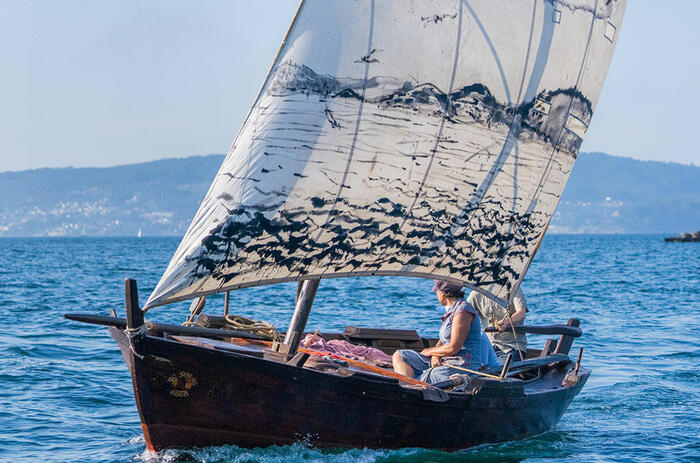
The Museum of Pontevedra exhibits Vento (wind, in Galician), the proposal that the artist Alberto Baraya (Bogota, Colombia, 1968) has developed and now shows at its headquarters in the Castelao Building as part of the cycle of exhibitions Infiltracións. This program aims to carry out specific projects that have as their backbone the dialogue arising from research and work with pieces from the collection of the Galician institution to promote re-readings on it.
VENTO BY ALBERTO BARAYA – IN PONTEVEDRA
The Museum of Pontevedra exhibits Vento (wind, in Galician), the proposal that the artist Alberto Baraya (Bogota, Colombia, 1968) has developed and now shows at its headquarters in the Castelao Building as part of the cycle of exhibitions Infiltracións. This program aims to carry out specific projects that have as their backbone the dialogue arising from research and work with pieces from the collection of the Galician institution to promote re-readings on it.

Based on the biologicist theories on territoriality and the relationships derived from living beings with their immediate environment, the Angeles Baños gallery from Badajoz proposes an exhibition project to three Latin American artists so that, through their experiences and their personal vision, they can materialize and express those feelings of territoriality, and always from the parallelism of the human being with the rest of living beings.
THE TERRITORIAL BY THREE LATIN AMERICAN ARTISTS AT ÁNGELES BAÑOS
Based on the biologicist theories on territoriality and the relationships derived from living beings with their immediate environment, the Angeles Baños gallery from Badajoz proposes an exhibition project to three Latin American artists so that, through their experiences and their personal vision, they can materialize and express those feelings of territoriality, and always from the parallelism of the human being with the rest of living beings.
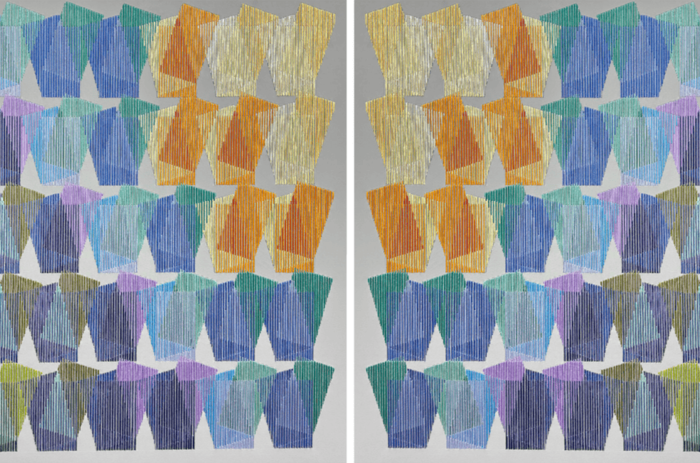
Isabella Despujols (Barquisemeto, Venezuela, 1994), Venezuelan artist based in Brazil, uses her artistic references for the realization of her latest series of works, a set made this year where textiles and embroidery are especially relevant, as well as the formal fact that they reflect. In them is palpable the conversation that he intends to maintain with those styles and languages that were fundamental in the countries to which he circumscribes his personal experience.
DESPUJOLS' EMBROIDERED GEOMETRY AT LLAMAZARES
Isabella Despujols (Barquisemeto, Venezuela, 1994), Venezuelan artist based in Brazil, uses her artistic references for the realization of her latest series of works, a set made this year where textiles and embroidery are especially relevant, as well as the formal fact that they reflect. In them is palpable the conversation that he intends to maintain with those styles and languages that were fundamental in the countries to which he circumscribes his personal experience.
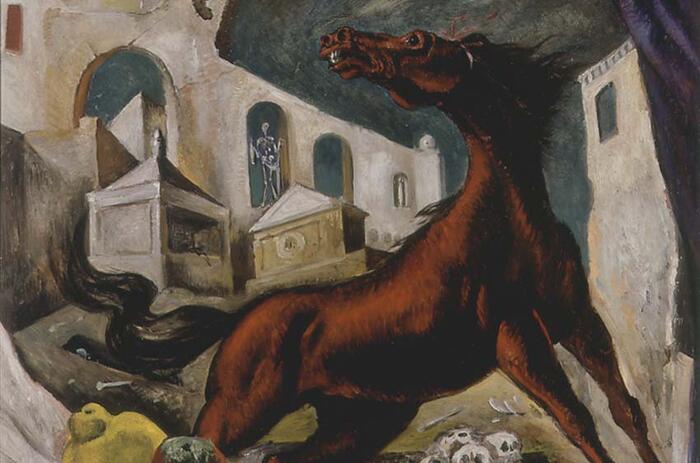
Fundación Casa de Mexico in Spain hosts the exhibition Modern Art of Mexico, with funds from the Blaisten Collection and curated by Daniel Garza Usabiaga, which takes an interesting look at the country's 20th century production through the eyes of Margarita Nelken (Madrid, Spain, 1894-Mexico City, Mexico, 1968).
MEXICAN MODERN ART ACCORDING TO NELKEN AND THE BLAISTEN COLLECTION
Fundación Casa de Mexico in Spain hosts the exhibition Modern Art of Mexico, with funds from the Blaisten Collection and curated by Daniel Garza Usabiaga, which takes an interesting look at the country's 20th century production through the eyes of Margarita Nelken (Madrid, Spain, 1894-Mexico City, Mexico, 1968).
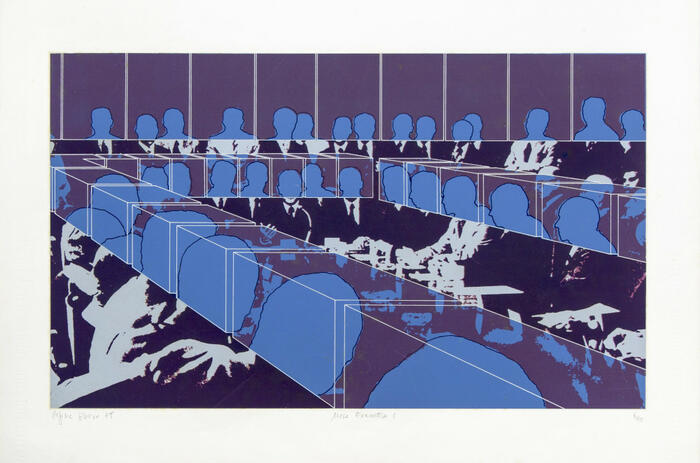
Barcelona's Center of Image La Virreina (La Virreina Centre de la Imatge) is dedicating an extensive exhibition to Regina Silveira (Porto Alegre, Brazil, 1939), one of the multimedia artists and key figures of Latin American conceptual art. Within the exhibition line of the center, which advocates the exploration of the aesthetic and ideological languages of images, this show curated by Isabella Lenzi covers a wide range of the Brazilian artist's research, experimentation and artistic production, particularly that developed with technical reproduction techniques and the circulation of images.
REGINA SILVEIRA'S DESTRUCTION OF POWER
Barcelona's Center of Image La Virreina (La Virreina Centre de la Imatge) is dedicating an extensive exhibition to Regina Silveira (Porto Alegre, Brazil, 1939), one of the multimedia artists and key figures of Latin American conceptual art. Within the exhibition line of the center, which advocates the exploration of the aesthetic and ideological languages of images, this show curated by Isabella Lenzi covers a wide range of the Brazilian artist's research, experimentation and artistic production, particularly that developed with technical reproduction techniques and the circulation of images.

The Studiotopia international program is open for the submission of proposals to the residency program for young scientists or emerging artists. LABoral Centro de Arte y Creación Industrial -in collaboration with other institutions- announces an international call for non-Spanish artists. Deadline to apply: November 7, 2024.
SCIENCE & ART: STUDIOTOPIA INTERNATIONAL OPEN CALL
The Studiotopia international program is open for the submission of proposals to the residency program for young scientists or emerging artists. LABoral Centro de Arte y Creación Industrial -in collaboration with other institutions- announces an international call for non-Spanish artists. Deadline to apply: November 7, 2024.

Pinta BAphoto closed its 20th anniversary at La Rural, Buenos Aires, Argentina, after a weekend that brought together the best of photography in the region and was a meeting point for gallery owners, artists, curators, collectors and photography lovers. The fair attracted more than 14,000 visitors during its three days open to the public.
PINTA BAphoto - THE EXPRESSION OF A REGION'S PHOTOGRAPHY
Pinta BAphoto closed its 20th anniversary at La Rural, Buenos Aires, Argentina, after a weekend that brought together the best of photography in the region and was a meeting point for gallery owners, artists, curators, collectors and photography lovers. The fair attracted more than 14,000 visitors during its three days open to the public.

Confines of Paraguay is the initiative of Fernando Allen and Fredi Casco that is part of the Main Section of Pinta BAphoto. It is a project that began with a photographic approach, but expanded into an editorial, audiovisual and documentary archive -along with other activities- related to the works of popular and indigenous artists from Paraguay.
FERNANDO ALLEN AND CONFINES OF PARAGUAY IN PINTA BAphoto 2024
Confines of Paraguay is the initiative of Fernando Allen and Fredi Casco that is part of the Main Section of Pinta BAphoto. It is a project that began with a photographic approach, but expanded into an editorial, audiovisual and documentary archive -along with other activities- related to the works of popular and indigenous artists from Paraguay.

The Andalusian Center for Contemporary Art (CAAC) is showing Continuum or the appearance of the parts and the whole in its recovered space in the cellars of the institution's complex in Seville, an exhibition whose origin is to be sought in Profundis, the proposal that Colombian Delcy Morelos (Tierralta, Colombia, 1967) made for this same center this year and that served as a framework to sublimate, from the analysis, the dialogue beyond the material and the relationship she kept with her collaborators when it came to putting together her recent exhibition.
CONTINUUM: FROM THE DIALOGUE WITH DELCY MORELOS
The Andalusian Center for Contemporary Art (CAAC) is showing Continuum or the appearance of the parts and the whole in its recovered space in the cellars of the institution's complex in Seville, an exhibition whose origin is to be sought in Profundis, the proposal that Colombian Delcy Morelos (Tierralta, Colombia, 1967) made for this same center this year and that served as a framework to sublimate, from the analysis, the dialogue beyond the material and the relationship she kept with her collaborators when it came to putting together her recent exhibition.

In an art industry that increasingly advocates following the lines established by cultural policies, it is always comforting to return to thesis themes, to environments that draw from social and historiographic sources, of course, but also from myths and a well-understood anthropology. You can go deeper in subtitles and lines or you can put together a skeleton, but the overview can also be a reward these days.
THE FIRE KEEPERS, A PERSPECTIVE ON THE MYTH OF FIRE FROM A MEXICAN CURATORIAL PERSPECTIVE
In an art industry that increasingly advocates following the lines established by cultural policies, it is always comforting to return to thesis themes, to environments that draw from social and historiographic sources, of course, but also from myths and a well-understood anthropology. You can go deeper in subtitles and lines or you can put together a skeleton, but the overview can also be a reward these days.

The Museo Moderno announced that La Menesunda, the legendary work by Marta Minujín and Rubén Santantonín –a work originally created in 1965, reconstructed by the Museo de Arte Moderno de Buenos Aires and inaugurated in 2015 and later in 2019 at the New Museum in New York– is on view for the first time in Europe as part of a tour that will show it in four countries.
THE EUROPEAN TOUR OF 'LA MENESUNDA' ACCORDING TO MARTA MINUJÍN
The Museo Moderno announced that La Menesunda, the legendary work by Marta Minujín and Rubén Santantonín –a work originally created in 1965, reconstructed by the Museo de Arte Moderno de Buenos Aires and inaugurated in 2015 and later in 2019 at the New Museum in New York– is on view for the first time in Europe as part of a tour that will show it in four countries.

Sol Calero (Caracas, Venezuela, 1982) uses the guanabana, a fruit endemic to Central America and the Caribbean, to symbolically instrumentalize the creation of a representation of the feelings of belonging, home, everyday life and stereotypes through the wide conquest of the spaces of the Museo Centro de Arte Dos de Mayo, transformed for the occasion into visual and popular references of a well-known and recognized Latin America.
IDENTITY AND HOME – ACCORDING TO SOL CALERO IN THE CA2M MUSEUM
Sol Calero (Caracas, Venezuela, 1982) uses the guanabana, a fruit endemic to Central America and the Caribbean, to symbolically instrumentalize the creation of a representation of the feelings of belonging, home, everyday life and stereotypes through the wide conquest of the spaces of the Museo Centro de Arte Dos de Mayo, transformed for the occasion into visual and popular references of a well-known and recognized Latin America.

The Museum of Pontevedra exhibits Vento (wind, in Galician), the proposal that the artist Alberto Baraya (Bogota, Colombia, 1968) has developed and now shows at its headquarters in the Castelao Building as part of the cycle of exhibitions Infiltracións. This program aims to carry out specific projects that have as their backbone the dialogue arising from research and work with pieces from the collection of the Galician institution to promote re-readings on it.
VENTO BY ALBERTO BARAYA – IN PONTEVEDRA
The Museum of Pontevedra exhibits Vento (wind, in Galician), the proposal that the artist Alberto Baraya (Bogota, Colombia, 1968) has developed and now shows at its headquarters in the Castelao Building as part of the cycle of exhibitions Infiltracións. This program aims to carry out specific projects that have as their backbone the dialogue arising from research and work with pieces from the collection of the Galician institution to promote re-readings on it.

Based on the biologicist theories on territoriality and the relationships derived from living beings with their immediate environment, the Angeles Baños gallery from Badajoz proposes an exhibition project to three Latin American artists so that, through their experiences and their personal vision, they can materialize and express those feelings of territoriality, and always from the parallelism of the human being with the rest of living beings.
THE TERRITORIAL BY THREE LATIN AMERICAN ARTISTS AT ÁNGELES BAÑOS
Based on the biologicist theories on territoriality and the relationships derived from living beings with their immediate environment, the Angeles Baños gallery from Badajoz proposes an exhibition project to three Latin American artists so that, through their experiences and their personal vision, they can materialize and express those feelings of territoriality, and always from the parallelism of the human being with the rest of living beings.

Isabella Despujols (Barquisemeto, Venezuela, 1994), Venezuelan artist based in Brazil, uses her artistic references for the realization of her latest series of works, a set made this year where textiles and embroidery are especially relevant, as well as the formal fact that they reflect. In them is palpable the conversation that he intends to maintain with those styles and languages that were fundamental in the countries to which he circumscribes his personal experience.
DESPUJOLS' EMBROIDERED GEOMETRY AT LLAMAZARES
Isabella Despujols (Barquisemeto, Venezuela, 1994), Venezuelan artist based in Brazil, uses her artistic references for the realization of her latest series of works, a set made this year where textiles and embroidery are especially relevant, as well as the formal fact that they reflect. In them is palpable the conversation that he intends to maintain with those styles and languages that were fundamental in the countries to which he circumscribes his personal experience.

Fundación Casa de Mexico in Spain hosts the exhibition Modern Art of Mexico, with funds from the Blaisten Collection and curated by Daniel Garza Usabiaga, which takes an interesting look at the country's 20th century production through the eyes of Margarita Nelken (Madrid, Spain, 1894-Mexico City, Mexico, 1968).
MEXICAN MODERN ART ACCORDING TO NELKEN AND THE BLAISTEN COLLECTION
Fundación Casa de Mexico in Spain hosts the exhibition Modern Art of Mexico, with funds from the Blaisten Collection and curated by Daniel Garza Usabiaga, which takes an interesting look at the country's 20th century production through the eyes of Margarita Nelken (Madrid, Spain, 1894-Mexico City, Mexico, 1968).

Barcelona's Center of Image La Virreina (La Virreina Centre de la Imatge) is dedicating an extensive exhibition to Regina Silveira (Porto Alegre, Brazil, 1939), one of the multimedia artists and key figures of Latin American conceptual art. Within the exhibition line of the center, which advocates the exploration of the aesthetic and ideological languages of images, this show curated by Isabella Lenzi covers a wide range of the Brazilian artist's research, experimentation and artistic production, particularly that developed with technical reproduction techniques and the circulation of images.
REGINA SILVEIRA'S DESTRUCTION OF POWER
Barcelona's Center of Image La Virreina (La Virreina Centre de la Imatge) is dedicating an extensive exhibition to Regina Silveira (Porto Alegre, Brazil, 1939), one of the multimedia artists and key figures of Latin American conceptual art. Within the exhibition line of the center, which advocates the exploration of the aesthetic and ideological languages of images, this show curated by Isabella Lenzi covers a wide range of the Brazilian artist's research, experimentation and artistic production, particularly that developed with technical reproduction techniques and the circulation of images.

The Studiotopia international program is open for the submission of proposals to the residency program for young scientists or emerging artists. LABoral Centro de Arte y Creación Industrial -in collaboration with other institutions- announces an international call for non-Spanish artists. Deadline to apply: November 7, 2024.
SCIENCE & ART: STUDIOTOPIA INTERNATIONAL OPEN CALL
The Studiotopia international program is open for the submission of proposals to the residency program for young scientists or emerging artists. LABoral Centro de Arte y Creación Industrial -in collaboration with other institutions- announces an international call for non-Spanish artists. Deadline to apply: November 7, 2024.

Pinta BAphoto closed its 20th anniversary at La Rural, Buenos Aires, Argentina, after a weekend that brought together the best of photography in the region and was a meeting point for gallery owners, artists, curators, collectors and photography lovers. The fair attracted more than 14,000 visitors during its three days open to the public.
PINTA BAphoto - THE EXPRESSION OF A REGION'S PHOTOGRAPHY
Pinta BAphoto closed its 20th anniversary at La Rural, Buenos Aires, Argentina, after a weekend that brought together the best of photography in the region and was a meeting point for gallery owners, artists, curators, collectors and photography lovers. The fair attracted more than 14,000 visitors during its three days open to the public.

Confines of Paraguay is the initiative of Fernando Allen and Fredi Casco that is part of the Main Section of Pinta BAphoto. It is a project that began with a photographic approach, but expanded into an editorial, audiovisual and documentary archive -along with other activities- related to the works of popular and indigenous artists from Paraguay.
FERNANDO ALLEN AND CONFINES OF PARAGUAY IN PINTA BAphoto 2024
Confines of Paraguay is the initiative of Fernando Allen and Fredi Casco that is part of the Main Section of Pinta BAphoto. It is a project that began with a photographic approach, but expanded into an editorial, audiovisual and documentary archive -along with other activities- related to the works of popular and indigenous artists from Paraguay.

The Andalusian Center for Contemporary Art (CAAC) is showing Continuum or the appearance of the parts and the whole in its recovered space in the cellars of the institution's complex in Seville, an exhibition whose origin is to be sought in Profundis, the proposal that Colombian Delcy Morelos (Tierralta, Colombia, 1967) made for this same center this year and that served as a framework to sublimate, from the analysis, the dialogue beyond the material and the relationship she kept with her collaborators when it came to putting together her recent exhibition.
CONTINUUM: FROM THE DIALOGUE WITH DELCY MORELOS
The Andalusian Center for Contemporary Art (CAAC) is showing Continuum or the appearance of the parts and the whole in its recovered space in the cellars of the institution's complex in Seville, an exhibition whose origin is to be sought in Profundis, the proposal that Colombian Delcy Morelos (Tierralta, Colombia, 1967) made for this same center this year and that served as a framework to sublimate, from the analysis, the dialogue beyond the material and the relationship she kept with her collaborators when it came to putting together her recent exhibition.

In an art industry that increasingly advocates following the lines established by cultural policies, it is always comforting to return to thesis themes, to environments that draw from social and historiographic sources, of course, but also from myths and a well-understood anthropology. You can go deeper in subtitles and lines or you can put together a skeleton, but the overview can also be a reward these days.
THE FIRE KEEPERS, A PERSPECTIVE ON THE MYTH OF FIRE FROM A MEXICAN CURATORIAL PERSPECTIVE
In an art industry that increasingly advocates following the lines established by cultural policies, it is always comforting to return to thesis themes, to environments that draw from social and historiographic sources, of course, but also from myths and a well-understood anthropology. You can go deeper in subtitles and lines or you can put together a skeleton, but the overview can also be a reward these days.

The Museo Moderno announced that La Menesunda, the legendary work by Marta Minujín and Rubén Santantonín –a work originally created in 1965, reconstructed by the Museo de Arte Moderno de Buenos Aires and inaugurated in 2015 and later in 2019 at the New Museum in New York– is on view for the first time in Europe as part of a tour that will show it in four countries.
THE EUROPEAN TOUR OF 'LA MENESUNDA' ACCORDING TO MARTA MINUJÍN
The Museo Moderno announced that La Menesunda, the legendary work by Marta Minujín and Rubén Santantonín –a work originally created in 1965, reconstructed by the Museo de Arte Moderno de Buenos Aires and inaugurated in 2015 and later in 2019 at the New Museum in New York– is on view for the first time in Europe as part of a tour that will show it in four countries.

Sol Calero (Caracas, Venezuela, 1982) uses the guanabana, a fruit endemic to Central America and the Caribbean, to symbolically instrumentalize the creation of a representation of the feelings of belonging, home, everyday life and stereotypes through the wide conquest of the spaces of the Museo Centro de Arte Dos de Mayo, transformed for the occasion into visual and popular references of a well-known and recognized Latin America.
IDENTITY AND HOME – ACCORDING TO SOL CALERO IN THE CA2M MUSEUM
Sol Calero (Caracas, Venezuela, 1982) uses the guanabana, a fruit endemic to Central America and the Caribbean, to symbolically instrumentalize the creation of a representation of the feelings of belonging, home, everyday life and stereotypes through the wide conquest of the spaces of the Museo Centro de Arte Dos de Mayo, transformed for the occasion into visual and popular references of a well-known and recognized Latin America.

The Museum of Pontevedra exhibits Vento (wind, in Galician), the proposal that the artist Alberto Baraya (Bogota, Colombia, 1968) has developed and now shows at its headquarters in the Castelao Building as part of the cycle of exhibitions Infiltracións. This program aims to carry out specific projects that have as their backbone the dialogue arising from research and work with pieces from the collection of the Galician institution to promote re-readings on it.
VENTO BY ALBERTO BARAYA – IN PONTEVEDRA
The Museum of Pontevedra exhibits Vento (wind, in Galician), the proposal that the artist Alberto Baraya (Bogota, Colombia, 1968) has developed and now shows at its headquarters in the Castelao Building as part of the cycle of exhibitions Infiltracións. This program aims to carry out specific projects that have as their backbone the dialogue arising from research and work with pieces from the collection of the Galician institution to promote re-readings on it.

Based on the biologicist theories on territoriality and the relationships derived from living beings with their immediate environment, the Angeles Baños gallery from Badajoz proposes an exhibition project to three Latin American artists so that, through their experiences and their personal vision, they can materialize and express those feelings of territoriality, and always from the parallelism of the human being with the rest of living beings.
THE TERRITORIAL BY THREE LATIN AMERICAN ARTISTS AT ÁNGELES BAÑOS
Based on the biologicist theories on territoriality and the relationships derived from living beings with their immediate environment, the Angeles Baños gallery from Badajoz proposes an exhibition project to three Latin American artists so that, through their experiences and their personal vision, they can materialize and express those feelings of territoriality, and always from the parallelism of the human being with the rest of living beings.

Isabella Despujols (Barquisemeto, Venezuela, 1994), Venezuelan artist based in Brazil, uses her artistic references for the realization of her latest series of works, a set made this year where textiles and embroidery are especially relevant, as well as the formal fact that they reflect. In them is palpable the conversation that he intends to maintain with those styles and languages that were fundamental in the countries to which he circumscribes his personal experience.
DESPUJOLS' EMBROIDERED GEOMETRY AT LLAMAZARES
Isabella Despujols (Barquisemeto, Venezuela, 1994), Venezuelan artist based in Brazil, uses her artistic references for the realization of her latest series of works, a set made this year where textiles and embroidery are especially relevant, as well as the formal fact that they reflect. In them is palpable the conversation that he intends to maintain with those styles and languages that were fundamental in the countries to which he circumscribes his personal experience.

Fundación Casa de Mexico in Spain hosts the exhibition Modern Art of Mexico, with funds from the Blaisten Collection and curated by Daniel Garza Usabiaga, which takes an interesting look at the country's 20th century production through the eyes of Margarita Nelken (Madrid, Spain, 1894-Mexico City, Mexico, 1968).
MEXICAN MODERN ART ACCORDING TO NELKEN AND THE BLAISTEN COLLECTION
Fundación Casa de Mexico in Spain hosts the exhibition Modern Art of Mexico, with funds from the Blaisten Collection and curated by Daniel Garza Usabiaga, which takes an interesting look at the country's 20th century production through the eyes of Margarita Nelken (Madrid, Spain, 1894-Mexico City, Mexico, 1968).

Barcelona's Center of Image La Virreina (La Virreina Centre de la Imatge) is dedicating an extensive exhibition to Regina Silveira (Porto Alegre, Brazil, 1939), one of the multimedia artists and key figures of Latin American conceptual art. Within the exhibition line of the center, which advocates the exploration of the aesthetic and ideological languages of images, this show curated by Isabella Lenzi covers a wide range of the Brazilian artist's research, experimentation and artistic production, particularly that developed with technical reproduction techniques and the circulation of images.
REGINA SILVEIRA'S DESTRUCTION OF POWER
Barcelona's Center of Image La Virreina (La Virreina Centre de la Imatge) is dedicating an extensive exhibition to Regina Silveira (Porto Alegre, Brazil, 1939), one of the multimedia artists and key figures of Latin American conceptual art. Within the exhibition line of the center, which advocates the exploration of the aesthetic and ideological languages of images, this show curated by Isabella Lenzi covers a wide range of the Brazilian artist's research, experimentation and artistic production, particularly that developed with technical reproduction techniques and the circulation of images.

The Studiotopia international program is open for the submission of proposals to the residency program for young scientists or emerging artists. LABoral Centro de Arte y Creación Industrial -in collaboration with other institutions- announces an international call for non-Spanish artists. Deadline to apply: November 7, 2024.
SCIENCE & ART: STUDIOTOPIA INTERNATIONAL OPEN CALL
The Studiotopia international program is open for the submission of proposals to the residency program for young scientists or emerging artists. LABoral Centro de Arte y Creación Industrial -in collaboration with other institutions- announces an international call for non-Spanish artists. Deadline to apply: November 7, 2024.

Pinta BAphoto closed its 20th anniversary at La Rural, Buenos Aires, Argentina, after a weekend that brought together the best of photography in the region and was a meeting point for gallery owners, artists, curators, collectors and photography lovers. The fair attracted more than 14,000 visitors during its three days open to the public.
PINTA BAphoto - THE EXPRESSION OF A REGION'S PHOTOGRAPHY
Pinta BAphoto closed its 20th anniversary at La Rural, Buenos Aires, Argentina, after a weekend that brought together the best of photography in the region and was a meeting point for gallery owners, artists, curators, collectors and photography lovers. The fair attracted more than 14,000 visitors during its three days open to the public.

Confines of Paraguay is the initiative of Fernando Allen and Fredi Casco that is part of the Main Section of Pinta BAphoto. It is a project that began with a photographic approach, but expanded into an editorial, audiovisual and documentary archive -along with other activities- related to the works of popular and indigenous artists from Paraguay.
FERNANDO ALLEN AND CONFINES OF PARAGUAY IN PINTA BAphoto 2024
Confines of Paraguay is the initiative of Fernando Allen and Fredi Casco that is part of the Main Section of Pinta BAphoto. It is a project that began with a photographic approach, but expanded into an editorial, audiovisual and documentary archive -along with other activities- related to the works of popular and indigenous artists from Paraguay.

The Andalusian Center for Contemporary Art (CAAC) is showing Continuum or the appearance of the parts and the whole in its recovered space in the cellars of the institution's complex in Seville, an exhibition whose origin is to be sought in Profundis, the proposal that Colombian Delcy Morelos (Tierralta, Colombia, 1967) made for this same center this year and that served as a framework to sublimate, from the analysis, the dialogue beyond the material and the relationship she kept with her collaborators when it came to putting together her recent exhibition.
CONTINUUM: FROM THE DIALOGUE WITH DELCY MORELOS
The Andalusian Center for Contemporary Art (CAAC) is showing Continuum or the appearance of the parts and the whole in its recovered space in the cellars of the institution's complex in Seville, an exhibition whose origin is to be sought in Profundis, the proposal that Colombian Delcy Morelos (Tierralta, Colombia, 1967) made for this same center this year and that served as a framework to sublimate, from the analysis, the dialogue beyond the material and the relationship she kept with her collaborators when it came to putting together her recent exhibition.

In an art industry that increasingly advocates following the lines established by cultural policies, it is always comforting to return to thesis themes, to environments that draw from social and historiographic sources, of course, but also from myths and a well-understood anthropology. You can go deeper in subtitles and lines or you can put together a skeleton, but the overview can also be a reward these days.
THE FIRE KEEPERS, A PERSPECTIVE ON THE MYTH OF FIRE FROM A MEXICAN CURATORIAL PERSPECTIVE
In an art industry that increasingly advocates following the lines established by cultural policies, it is always comforting to return to thesis themes, to environments that draw from social and historiographic sources, of course, but also from myths and a well-understood anthropology. You can go deeper in subtitles and lines or you can put together a skeleton, but the overview can also be a reward these days.

The Museo Moderno announced that La Menesunda, the legendary work by Marta Minujín and Rubén Santantonín –a work originally created in 1965, reconstructed by the Museo de Arte Moderno de Buenos Aires and inaugurated in 2015 and later in 2019 at the New Museum in New York– is on view for the first time in Europe as part of a tour that will show it in four countries.
THE EUROPEAN TOUR OF 'LA MENESUNDA' ACCORDING TO MARTA MINUJÍN
The Museo Moderno announced that La Menesunda, the legendary work by Marta Minujín and Rubén Santantonín –a work originally created in 1965, reconstructed by the Museo de Arte Moderno de Buenos Aires and inaugurated in 2015 and later in 2019 at the New Museum in New York– is on view for the first time in Europe as part of a tour that will show it in four countries.

Sol Calero (Caracas, Venezuela, 1982) uses the guanabana, a fruit endemic to Central America and the Caribbean, to symbolically instrumentalize the creation of a representation of the feelings of belonging, home, everyday life and stereotypes through the wide conquest of the spaces of the Museo Centro de Arte Dos de Mayo, transformed for the occasion into visual and popular references of a well-known and recognized Latin America.
IDENTITY AND HOME – ACCORDING TO SOL CALERO IN THE CA2M MUSEUM
Sol Calero (Caracas, Venezuela, 1982) uses the guanabana, a fruit endemic to Central America and the Caribbean, to symbolically instrumentalize the creation of a representation of the feelings of belonging, home, everyday life and stereotypes through the wide conquest of the spaces of the Museo Centro de Arte Dos de Mayo, transformed for the occasion into visual and popular references of a well-known and recognized Latin America.

The Museum of Pontevedra exhibits Vento (wind, in Galician), the proposal that the artist Alberto Baraya (Bogota, Colombia, 1968) has developed and now shows at its headquarters in the Castelao Building as part of the cycle of exhibitions Infiltracións. This program aims to carry out specific projects that have as their backbone the dialogue arising from research and work with pieces from the collection of the Galician institution to promote re-readings on it.
VENTO BY ALBERTO BARAYA – IN PONTEVEDRA
The Museum of Pontevedra exhibits Vento (wind, in Galician), the proposal that the artist Alberto Baraya (Bogota, Colombia, 1968) has developed and now shows at its headquarters in the Castelao Building as part of the cycle of exhibitions Infiltracións. This program aims to carry out specific projects that have as their backbone the dialogue arising from research and work with pieces from the collection of the Galician institution to promote re-readings on it.

Based on the biologicist theories on territoriality and the relationships derived from living beings with their immediate environment, the Angeles Baños gallery from Badajoz proposes an exhibition project to three Latin American artists so that, through their experiences and their personal vision, they can materialize and express those feelings of territoriality, and always from the parallelism of the human being with the rest of living beings.
THE TERRITORIAL BY THREE LATIN AMERICAN ARTISTS AT ÁNGELES BAÑOS
Based on the biologicist theories on territoriality and the relationships derived from living beings with their immediate environment, the Angeles Baños gallery from Badajoz proposes an exhibition project to three Latin American artists so that, through their experiences and their personal vision, they can materialize and express those feelings of territoriality, and always from the parallelism of the human being with the rest of living beings.

Isabella Despujols (Barquisemeto, Venezuela, 1994), Venezuelan artist based in Brazil, uses her artistic references for the realization of her latest series of works, a set made this year where textiles and embroidery are especially relevant, as well as the formal fact that they reflect. In them is palpable the conversation that he intends to maintain with those styles and languages that were fundamental in the countries to which he circumscribes his personal experience.
DESPUJOLS' EMBROIDERED GEOMETRY AT LLAMAZARES
Isabella Despujols (Barquisemeto, Venezuela, 1994), Venezuelan artist based in Brazil, uses her artistic references for the realization of her latest series of works, a set made this year where textiles and embroidery are especially relevant, as well as the formal fact that they reflect. In them is palpable the conversation that he intends to maintain with those styles and languages that were fundamental in the countries to which he circumscribes his personal experience.

Fundación Casa de Mexico in Spain hosts the exhibition Modern Art of Mexico, with funds from the Blaisten Collection and curated by Daniel Garza Usabiaga, which takes an interesting look at the country's 20th century production through the eyes of Margarita Nelken (Madrid, Spain, 1894-Mexico City, Mexico, 1968).
MEXICAN MODERN ART ACCORDING TO NELKEN AND THE BLAISTEN COLLECTION
Fundación Casa de Mexico in Spain hosts the exhibition Modern Art of Mexico, with funds from the Blaisten Collection and curated by Daniel Garza Usabiaga, which takes an interesting look at the country's 20th century production through the eyes of Margarita Nelken (Madrid, Spain, 1894-Mexico City, Mexico, 1968).

Barcelona's Center of Image La Virreina (La Virreina Centre de la Imatge) is dedicating an extensive exhibition to Regina Silveira (Porto Alegre, Brazil, 1939), one of the multimedia artists and key figures of Latin American conceptual art. Within the exhibition line of the center, which advocates the exploration of the aesthetic and ideological languages of images, this show curated by Isabella Lenzi covers a wide range of the Brazilian artist's research, experimentation and artistic production, particularly that developed with technical reproduction techniques and the circulation of images.
REGINA SILVEIRA'S DESTRUCTION OF POWER
Barcelona's Center of Image La Virreina (La Virreina Centre de la Imatge) is dedicating an extensive exhibition to Regina Silveira (Porto Alegre, Brazil, 1939), one of the multimedia artists and key figures of Latin American conceptual art. Within the exhibition line of the center, which advocates the exploration of the aesthetic and ideological languages of images, this show curated by Isabella Lenzi covers a wide range of the Brazilian artist's research, experimentation and artistic production, particularly that developed with technical reproduction techniques and the circulation of images.

The Studiotopia international program is open for the submission of proposals to the residency program for young scientists or emerging artists. LABoral Centro de Arte y Creación Industrial -in collaboration with other institutions- announces an international call for non-Spanish artists. Deadline to apply: November 7, 2024.
SCIENCE & ART: STUDIOTOPIA INTERNATIONAL OPEN CALL
The Studiotopia international program is open for the submission of proposals to the residency program for young scientists or emerging artists. LABoral Centro de Arte y Creación Industrial -in collaboration with other institutions- announces an international call for non-Spanish artists. Deadline to apply: November 7, 2024.

Pinta BAphoto closed its 20th anniversary at La Rural, Buenos Aires, Argentina, after a weekend that brought together the best of photography in the region and was a meeting point for gallery owners, artists, curators, collectors and photography lovers. The fair attracted more than 14,000 visitors during its three days open to the public.
PINTA BAphoto - THE EXPRESSION OF A REGION'S PHOTOGRAPHY
Pinta BAphoto closed its 20th anniversary at La Rural, Buenos Aires, Argentina, after a weekend that brought together the best of photography in the region and was a meeting point for gallery owners, artists, curators, collectors and photography lovers. The fair attracted more than 14,000 visitors during its three days open to the public.

Confines of Paraguay is the initiative of Fernando Allen and Fredi Casco that is part of the Main Section of Pinta BAphoto. It is a project that began with a photographic approach, but expanded into an editorial, audiovisual and documentary archive -along with other activities- related to the works of popular and indigenous artists from Paraguay.
FERNANDO ALLEN AND CONFINES OF PARAGUAY IN PINTA BAphoto 2024
Confines of Paraguay is the initiative of Fernando Allen and Fredi Casco that is part of the Main Section of Pinta BAphoto. It is a project that began with a photographic approach, but expanded into an editorial, audiovisual and documentary archive -along with other activities- related to the works of popular and indigenous artists from Paraguay.

The Andalusian Center for Contemporary Art (CAAC) is showing Continuum or the appearance of the parts and the whole in its recovered space in the cellars of the institution's complex in Seville, an exhibition whose origin is to be sought in Profundis, the proposal that Colombian Delcy Morelos (Tierralta, Colombia, 1967) made for this same center this year and that served as a framework to sublimate, from the analysis, the dialogue beyond the material and the relationship she kept with her collaborators when it came to putting together her recent exhibition.
CONTINUUM: FROM THE DIALOGUE WITH DELCY MORELOS
The Andalusian Center for Contemporary Art (CAAC) is showing Continuum or the appearance of the parts and the whole in its recovered space in the cellars of the institution's complex in Seville, an exhibition whose origin is to be sought in Profundis, the proposal that Colombian Delcy Morelos (Tierralta, Colombia, 1967) made for this same center this year and that served as a framework to sublimate, from the analysis, the dialogue beyond the material and the relationship she kept with her collaborators when it came to putting together her recent exhibition.

In an art industry that increasingly advocates following the lines established by cultural policies, it is always comforting to return to thesis themes, to environments that draw from social and historiographic sources, of course, but also from myths and a well-understood anthropology. You can go deeper in subtitles and lines or you can put together a skeleton, but the overview can also be a reward these days.
THE FIRE KEEPERS, A PERSPECTIVE ON THE MYTH OF FIRE FROM A MEXICAN CURATORIAL PERSPECTIVE
In an art industry that increasingly advocates following the lines established by cultural policies, it is always comforting to return to thesis themes, to environments that draw from social and historiographic sources, of course, but also from myths and a well-understood anthropology. You can go deeper in subtitles and lines or you can put together a skeleton, but the overview can also be a reward these days.

The Museo Moderno announced that La Menesunda, the legendary work by Marta Minujín and Rubén Santantonín –a work originally created in 1965, reconstructed by the Museo de Arte Moderno de Buenos Aires and inaugurated in 2015 and later in 2019 at the New Museum in New York– is on view for the first time in Europe as part of a tour that will show it in four countries.
THE EUROPEAN TOUR OF 'LA MENESUNDA' ACCORDING TO MARTA MINUJÍN
The Museo Moderno announced that La Menesunda, the legendary work by Marta Minujín and Rubén Santantonín –a work originally created in 1965, reconstructed by the Museo de Arte Moderno de Buenos Aires and inaugurated in 2015 and later in 2019 at the New Museum in New York– is on view for the first time in Europe as part of a tour that will show it in four countries.

Sol Calero (Caracas, Venezuela, 1982) uses the guanabana, a fruit endemic to Central America and the Caribbean, to symbolically instrumentalize the creation of a representation of the feelings of belonging, home, everyday life and stereotypes through the wide conquest of the spaces of the Museo Centro de Arte Dos de Mayo, transformed for the occasion into visual and popular references of a well-known and recognized Latin America.
IDENTITY AND HOME – ACCORDING TO SOL CALERO IN THE CA2M MUSEUM
Sol Calero (Caracas, Venezuela, 1982) uses the guanabana, a fruit endemic to Central America and the Caribbean, to symbolically instrumentalize the creation of a representation of the feelings of belonging, home, everyday life and stereotypes through the wide conquest of the spaces of the Museo Centro de Arte Dos de Mayo, transformed for the occasion into visual and popular references of a well-known and recognized Latin America.

The Museum of Pontevedra exhibits Vento (wind, in Galician), the proposal that the artist Alberto Baraya (Bogota, Colombia, 1968) has developed and now shows at its headquarters in the Castelao Building as part of the cycle of exhibitions Infiltracións. This program aims to carry out specific projects that have as their backbone the dialogue arising from research and work with pieces from the collection of the Galician institution to promote re-readings on it.
VENTO BY ALBERTO BARAYA – IN PONTEVEDRA
The Museum of Pontevedra exhibits Vento (wind, in Galician), the proposal that the artist Alberto Baraya (Bogota, Colombia, 1968) has developed and now shows at its headquarters in the Castelao Building as part of the cycle of exhibitions Infiltracións. This program aims to carry out specific projects that have as their backbone the dialogue arising from research and work with pieces from the collection of the Galician institution to promote re-readings on it.

Based on the biologicist theories on territoriality and the relationships derived from living beings with their immediate environment, the Angeles Baños gallery from Badajoz proposes an exhibition project to three Latin American artists so that, through their experiences and their personal vision, they can materialize and express those feelings of territoriality, and always from the parallelism of the human being with the rest of living beings.
THE TERRITORIAL BY THREE LATIN AMERICAN ARTISTS AT ÁNGELES BAÑOS
Based on the biologicist theories on territoriality and the relationships derived from living beings with their immediate environment, the Angeles Baños gallery from Badajoz proposes an exhibition project to three Latin American artists so that, through their experiences and their personal vision, they can materialize and express those feelings of territoriality, and always from the parallelism of the human being with the rest of living beings.

Isabella Despujols (Barquisemeto, Venezuela, 1994), Venezuelan artist based in Brazil, uses her artistic references for the realization of her latest series of works, a set made this year where textiles and embroidery are especially relevant, as well as the formal fact that they reflect. In them is palpable the conversation that he intends to maintain with those styles and languages that were fundamental in the countries to which he circumscribes his personal experience.
DESPUJOLS' EMBROIDERED GEOMETRY AT LLAMAZARES
Isabella Despujols (Barquisemeto, Venezuela, 1994), Venezuelan artist based in Brazil, uses her artistic references for the realization of her latest series of works, a set made this year where textiles and embroidery are especially relevant, as well as the formal fact that they reflect. In them is palpable the conversation that he intends to maintain with those styles and languages that were fundamental in the countries to which he circumscribes his personal experience.

Fundación Casa de Mexico in Spain hosts the exhibition Modern Art of Mexico, with funds from the Blaisten Collection and curated by Daniel Garza Usabiaga, which takes an interesting look at the country's 20th century production through the eyes of Margarita Nelken (Madrid, Spain, 1894-Mexico City, Mexico, 1968).
MEXICAN MODERN ART ACCORDING TO NELKEN AND THE BLAISTEN COLLECTION
Fundación Casa de Mexico in Spain hosts the exhibition Modern Art of Mexico, with funds from the Blaisten Collection and curated by Daniel Garza Usabiaga, which takes an interesting look at the country's 20th century production through the eyes of Margarita Nelken (Madrid, Spain, 1894-Mexico City, Mexico, 1968).

Barcelona's Center of Image La Virreina (La Virreina Centre de la Imatge) is dedicating an extensive exhibition to Regina Silveira (Porto Alegre, Brazil, 1939), one of the multimedia artists and key figures of Latin American conceptual art. Within the exhibition line of the center, which advocates the exploration of the aesthetic and ideological languages of images, this show curated by Isabella Lenzi covers a wide range of the Brazilian artist's research, experimentation and artistic production, particularly that developed with technical reproduction techniques and the circulation of images.
REGINA SILVEIRA'S DESTRUCTION OF POWER
Barcelona's Center of Image La Virreina (La Virreina Centre de la Imatge) is dedicating an extensive exhibition to Regina Silveira (Porto Alegre, Brazil, 1939), one of the multimedia artists and key figures of Latin American conceptual art. Within the exhibition line of the center, which advocates the exploration of the aesthetic and ideological languages of images, this show curated by Isabella Lenzi covers a wide range of the Brazilian artist's research, experimentation and artistic production, particularly that developed with technical reproduction techniques and the circulation of images.

